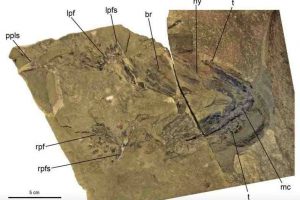
New research based on x-ray imaging provides the strongest evidence to date that sharks arose from a group of bony fishes called acanthodians. Analyzing an extraordinarily well-preserved fossil of an ancient sharklike fish, researchers identified it as an important transitional species that points to sharks as ancanthodians’ living descendants. The work is published in the journal American Museum Novitates.
“Major vertebrate evolutionary transitions, such as ‘fin to limb’ and ‘dinosaur to bird’ are substantiated by numerous fossil discoveries,” said John Maisey, the lead author of the study and the Herbert R. and Evelyn Axelrod Research Curator in the American Museum of Natural History’s Division of Paleontology. “By contrast, the much earlier rise of sharklike fishes within jawed vertebrates is poorly documented. Although this ‘fish to fish’ transition involved less profound anatomical reorganization than the evolutions of tetrapods or birds, it is no less important for informing the evolutionary origins of modern vertebrate diversity.”
In 2003, this question in vertebrate evolution was revitalized by the discovery of a remarkable fossil skeleton of a sharklike fish in New Brunswick, Canada. Named Doliodus problematicus, this species lived during the lower Devonian, between about 397 and 400 million years ago. When its discovery was announced, D. problematicus was shown to have paired spines in front of its pectoral (shoulder) fins, a feature otherwise known mainly in acanthodians. But in 2009 and 2014, Maisey and colleagues determined that the animal’s head, skeleton, and teeth were actually more like those of sharks than acanthodians.
The new study, based on computed tomography (CT) imaging at the French National Museum of Natural History in Paris, uncovered even more spines that are buried
inside the matrix of the fossil. These spines likely lined the underside of the fish, a distinguishing characteristic of acanthodians that confirms the fossil is evidence of an important transitional species.
“The arrangement of these spines shows unequivocally that this fish was basically an acanthodian with a shark’s head, pectoral skeleton, and teeth,” Maisey said.
Note: The above post is reprinted from materials provided by American Museum of Natural History.










